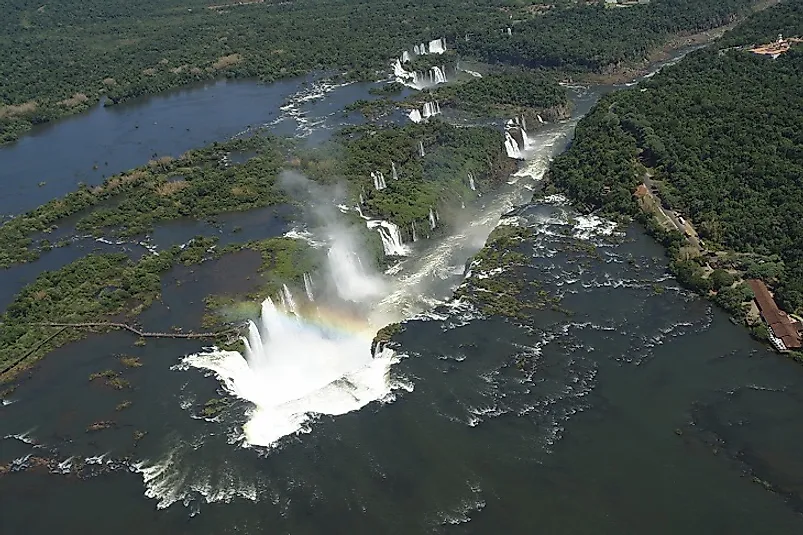The Mamore River

5. Description
The Mamore River flows through Bolivia and Brazil. Its length is estimated at around 1,200 miles as it flows through the Andes Mountains into the Bolivian lowlands and then into Brazil. It’s considered a "wild" or "untamed" river, as it has no obstacles like dams or levees hindering its flow. The Mamore River also changes its course to suit its flow, thereby creating several lagoons. Along the Brazilian border, the Mamore joins with the Beni River to form the Madeira River, the largest of the Amazon River's tributaries. In dry seasons, the low water levels leave wonderful beaches, while in the rainy seasons an abundance of plant matter is ripped away from its banks and carried off by the Mamore's currents.
4. Historical Role
The Beni and Mamore rapids were discovered by explorer Jose Agustin Palacios in 1846, though it was in 1883 that the area's prospects in economic terms came to fruition. In that year, famous Bolivian rubber baron Nicolas Suarez Callau established his growing company’s headquarters next to where the River Beni and the Mamore converged to form Madeira River. The location enabled Suarez to supervise his rubber consignment's movements. Furthermore, the natural obstacles created by the rapids compelled travelers to use his own ships to avoid the rapids. These two factors allowed Suarez to expand his entire business empire from the monetary gains he realized.
3. Modern Significance
The Mamore and Itenez Rivers combine to form the Itenez-Mamore Binational Corridor along the Bolivia and Brazilian border. This corridor shelters vast numbers of fish species, as well as vital populations of the Giant River otter, River dolphins, and South American birds. The corridor also supports the 1,389,025-hectare Itenez Protected Area (PA,) which is inclusive of humid forests, savannah, river forests, rivers, lakes, island forests, and other unique ecosystems. This protected area has 490 species of vegetation and 714 animal species living within its bounds, according to World Wildlife Fund (WWF). Within these animal species, there are 74 mammals, 360 birds, 45 reptiles, 42 amphibians, and 192 fish species. The Itenez Protected Area also provides livelihoods to indigenous and peasant communities there. There also are riverboat cruises that draw visitors to the Mamore and Madeira Rivers, bringing in tourism income for both countries in and around the rivers.
2. Habitat
The habitats around the Mamore River include tropical, sub-tropical, and aquatic biomes. Freshwater habitats of the Mamore River are comprised by aquatic vegetation like the floating plants eichhornia, pistia, and salvinia, grasses like hymenachne and panicum, and submerged plants like the utrucularia foliosa. Along the Mamore River's flow are three terrestrial habitats. On the eastern Andes mountain slopes is an area of montane and lowland forest zones. Then lowland forests to the north and east, which form the expansive Southwest Amazon moist forest region, have forests that are the seasonally flooded, as well as palm swamps covered with Buriti (Moriche) palm trees. To the east is the Llanos de Moxos, a huge savannah and wetland area covered with sedges and grasses, according to the Fresh Water Ecoregions of the World (FEOW).
1. Threats and Disputes
Increased human population pressures along the Mamore and Beni Rivers are increasing the strain on the area's natural resources, resulting in environmental degradation on a massive scale. Species in both rivers, especially the endangered River dolphins, face death by direct human killing and from being entangled in fishing nets, according to a South American Whales and Dolphins report. Mercury poisoning is also a problem in the Upper reaches of the Beni River, largely due to the pollution of the proximate environment from the artisanal gold mines that are located there. The imminent construction of new hydroelectric dams on the Madeira River is also viewed by researchers as detrimental to the aquatic species the river sustains, as well as all those that ultimately flow into it, including the Mamore. Furthermore, commercial agriculture is another threat to the Mamore and Beni Rivers' ecosystems, as natural forests are destroyed for farming, and pesticide and fertilizer runoffs pollute the Mamore's waterways.











